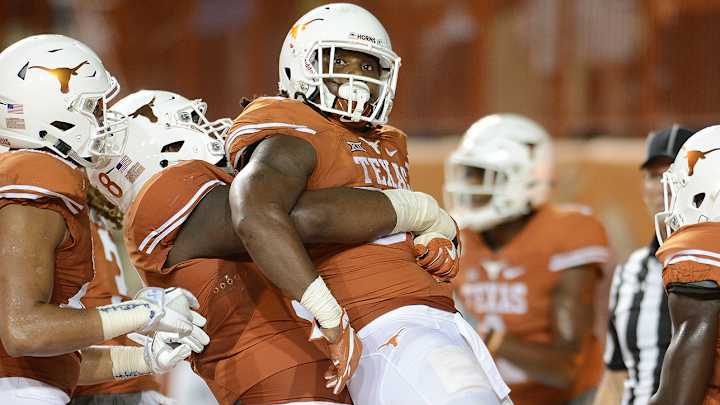D'Onta Foreman shows up at combine lighter and ready to run with the draft's top backs

INDIANAPOLIS — D’Onta Foreman is willing to do just about whatever it takes to play at a lighter weight in the NFL than he did in college.
Just do not ask him to eat quinoa.
“It’s terrible.”
The Texas running back who was the nation’s second-leading rusher last fall weighed in at 233 pounds during the NFL scouting combine, down 16 pounds from his listed weight in college. To be fair, he revealed that his school media guide measurables were a bit misleading.
“I played in between 240 and 245,” Foreman said, “kind of went up and down, never got higher than 245.”
However heavy he actually was, it worked. As a junior this past season, Foreman carried the ball 323 times for 2,028 yards and seven touchdowns. His lowest output of the season was a 24-carry, 124-yard effort in a loss at Kansas State, one of just three games in which he failed to score a touchdown. Foreman had a pair of 250-yard games (Baylor and Kansas) and a ridiculous 341 yards at Texas Tech.
Is it true that you can’t teach speed? Expert Q&A on NFL Combine 40-yard dash training
His size profiles him as a bell-cow back at the next level, even if his game often relies as much on his lateral agility as it does plowing through defenders.
“I would say I’m a big back, but I’ve definitely got some wiggle to me,” Foreman said. “I definitely can make people miss. I can run by people when I get past them. I feel like I’ve got a lot in me and I’m ready to show that in the next level.”
Foreman is different in that regard than, say, Le’Veon Bell, who recut his figure prior to his NFL arrival and in the process transformed from a power back to an agile superstar. Foreman is more of a side-to-side back by nature than Bell was entering the league, and Foreman should top Bell’s 40 time of 4.6 seconds, too.
Dropping weight was more about making sure he was at his peak for this critical set of tests in Indianapolis.
“I knew coming in that was going to be a big concern about my weight, where I was going to come in at,” Foreman said, “so I definitely focused on eating better and making sure that my weight was down. And I feel good now.”
Why the Wonderlic test is an outdated method of thinking about NFL intelligence
O.K., so the quinoa. It falls under that “eating better” umbrella—part of Foreman’s post-college, pre-combine training at EXOS, where many of the draft hopefuls train. “I just had to learn how to eat,” Foreman said. “I found a way to eat some stuff I never ate before. Some of it I didn’t like, some of it was good.”
Foreman would prefer to keep his weight in the mid-230s, right around where two of Texas’s most famous NFL products, Ricky Williams and Earl Campbell, were during their NFL careers.
“I’ve been blessed to be able to talk with both of those guys,” Foreman said. “I talked to Ricky last night, I was texting with him last night. Earl Campbell, I’m waiting to get back to Austin so I can go over and talk to him a little bit more. I learned a lot from Ricky this past season, I would text him after almost every game, just see what he saw. He always gave me feedback.”
Williams rushed for 10,000 yards during his career. Campbell is a Hall of Famer. Can Foreman follow in those footsteps? Time will tell, but he saw a better opportunity to do so a little slimmed down from his Texas form.
“I was comfortable at 240, 245—I rushed for 2,000 [yards] at that weight. I [thought], what could I be if I was smaller than that?”
